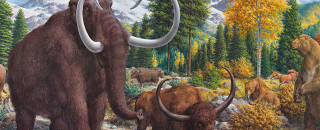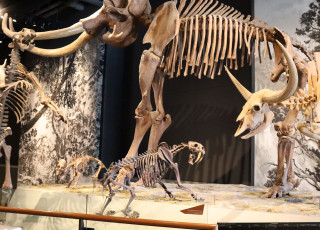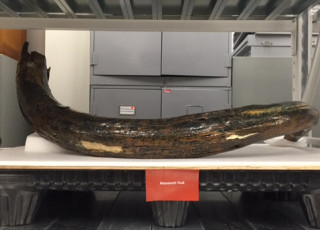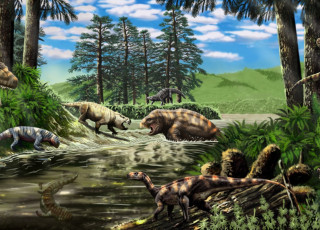Loss of ancient grazers triggered a global rise in fires
By Lisa Potter
From 50,000 to 6,000 years ago, many of the world’s largest animals, including such iconic grassland species as the woolly mammoth, giant bison, and ancient horses, went extinct. The loss of these grazing species triggered a dramatic increase in fire activity across the world’s grasslands, according to a new Yale-led study published Nov. 26 in the journal Science.
“We show that herbivore extinctions caused a fundamental shift to a more flammable world,” said co-author Tyler Faith, curator of archaeology at the Natural History Museum of Utah and associate professor of anthropology at the University of Utah. “Grasslands are the most flammable ecosystems on the planet. If enough prehistoric herbivores were distributed across ancient grasslands and eating tons of grass, they were probably suppressing wildfires. Until now, we didn’t know whether it mattered on a large scale.”
The scientists compiled lists of extinct large mammals and their approximate dates of extinctions across four continents. The data showed that South America lost the most grazers (83% of all species), followed by North America (68%). These losses were significantly higher than in Australia (44%) and Africa (22%).
They then compared these findings with records of fire activity as revealed in lake sediments. Using charcoal records from 410 global sites, which provided a prehistoric record of regional fire activity across continents, they found that fire activity increased after the grazer extinctions. Continents that lost more grazers (South America, then North America) saw larger increases in fire activity, whereas continents that saw lower rates of extinction (Australia and Africa) saw little change in grassland fire.
Widespread megaherbivore extinctions had major impacts on ecosystems — ranging from predator collapse to loss of fruit-bearing trees that once depended on herbivores for dispersal. But the authors wondered if there was also an increase in fire activity in the world’s ecosystems, specifically due to a buildup of dry grass, leaves, or wood caused by the loss of giant herbivores. They found that, in grasslands, grass-fueled fires increased.
“These extinctions led to a cascade of consequences,” said Allison Karp, a postdoctoral associate in Yale’s Department of Ecology & Evolutionary Biology and lead author of the paper. “Studying these effects helps us understand how herbivores shape global ecology today.”
However, the authors note that many ancient browser species — such as mastodons, diprotodons, and giant sloths, which foraged on shrubs and trees in wooded areas — also went extinct during the same period but that their losses had less impact on fires in wooded areas.
Grassland ecosystems across the world were transformed after the loss of grazing-tolerant grasses due to the loss of herbivores and increase in fires. New grazers, including livestock, eventually adapted to the new ecosystems.
That’s why scientists should consider the role of grazing livestock and wild grazers in fire mitigation and climate change, the authors said. “This work really highlights how important grazers may be for shaping fire activity,” said senior author Carla Staver, associate professor of ecology and evolutionary biology at Yale. “We need to pay close attention to these interactions if we want to accurately predict the future of fires.”
“When you spend all summer choking on smoke like we did here in Utah, wildfire is viewed as the enemy. But we forget that fire is part of the earth system,” said Faith. “It’s sensitive to this interplay between what’s going on with the climate, what’s going on with herbivores, and more recently, what’s going on with humans.”
Lisa Potter is a science communications specialist at the University of Utah in Salt Lake City. The Natural History Museum of Utah is part of the University of Utah. NHMU's mission is to illuminate the natural world and the place of humans within it. In addition to housing outstanding exhibits for the public, NHMU is a research museum. Learn more.
This post was adapted from a release by Bill Hathaway at Yale.



